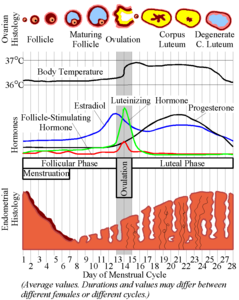Menstrual Cycle
Proliferative Phase, Secretory Phase, Menstruation

The menstrual cycle technically refers to the cyclic changes that take place in the lining of the human uterus over the course of approximately 28 days in adult females. These cycle changes are associated with cyclic changes in the ovaries and in the brain and ovarian hormones. The term "menstrual" comes from the Latin word menses, meaning month. The purpose of the cyclic changes is to prepare the uterine lining, called the endometrium, to receive a fertilized egg (the zygote). In response to hormone levels, the endometrium thickens as a result of increases in the cells and blood vessels. If fertilized action does not occur, the uterine lining breaks down. The blood, mucus, and pieces of tissue of the thickened endometrial lining are sloughed off through the cervix of the uterus and out of the vagina, in a process called menstruation.
The first phase of the menstrual cycle in the uterus is the proliferative phase, which is followed by the secretory phase, and then by menstruation. Cyclic changes in hormonal levels control and orchestrate the events of the menstrual cycle.
Additional topics
- Menstrual Cycle - Proliferative Phase
- Menstrual Cycle - Secretory Phase
- Menstrual Cycle - Menstruation
- Other Free Encyclopedias
Science EncyclopediaScience & Philosophy: Mathematics to Methanal trimer